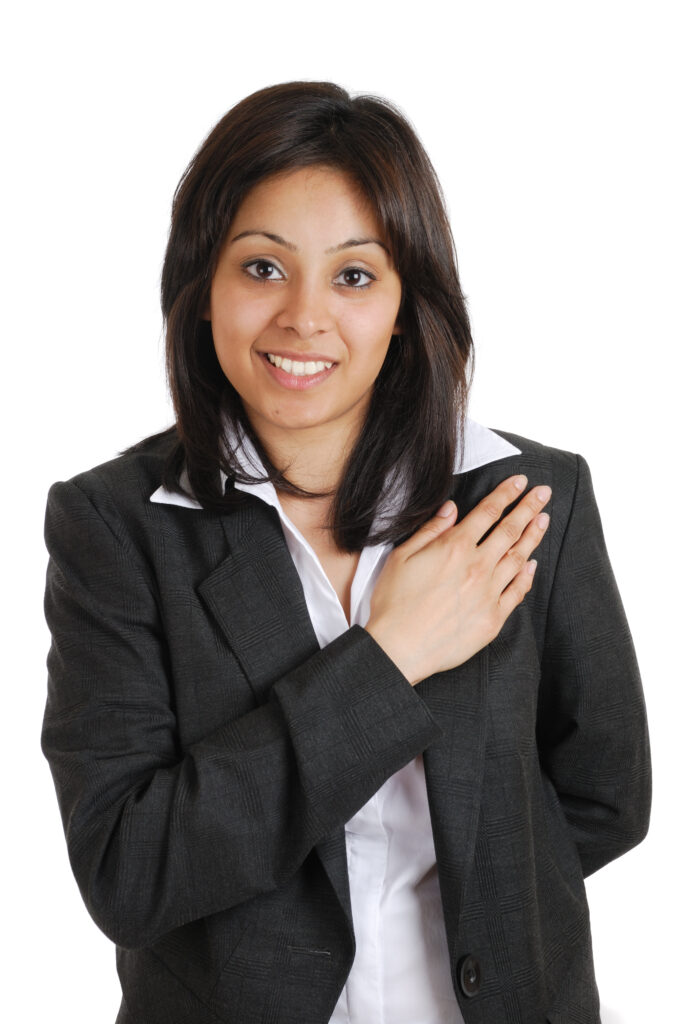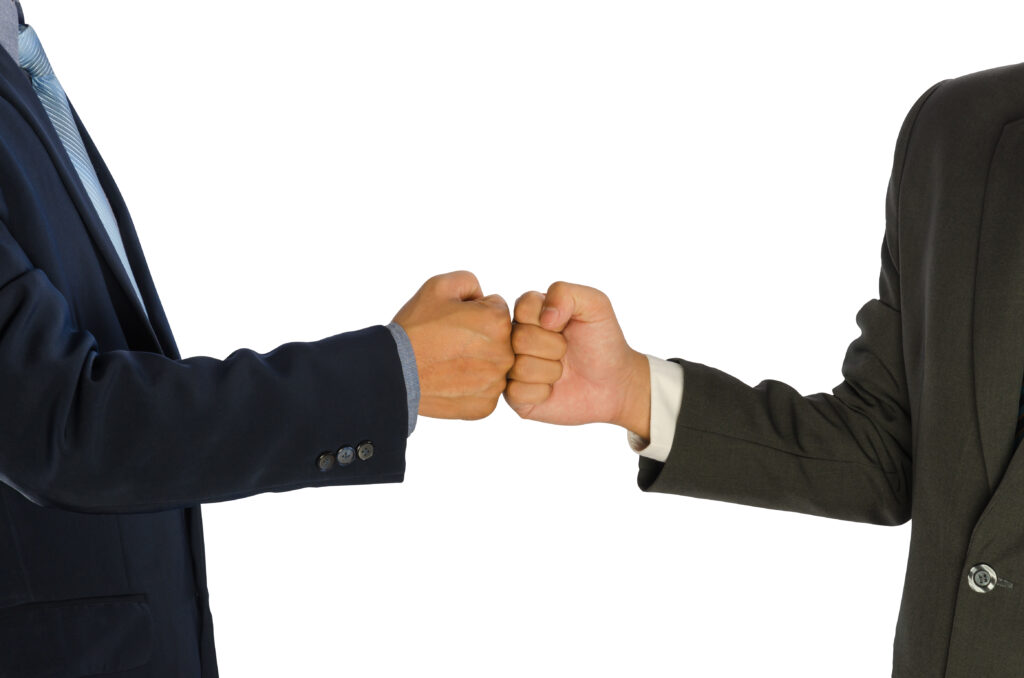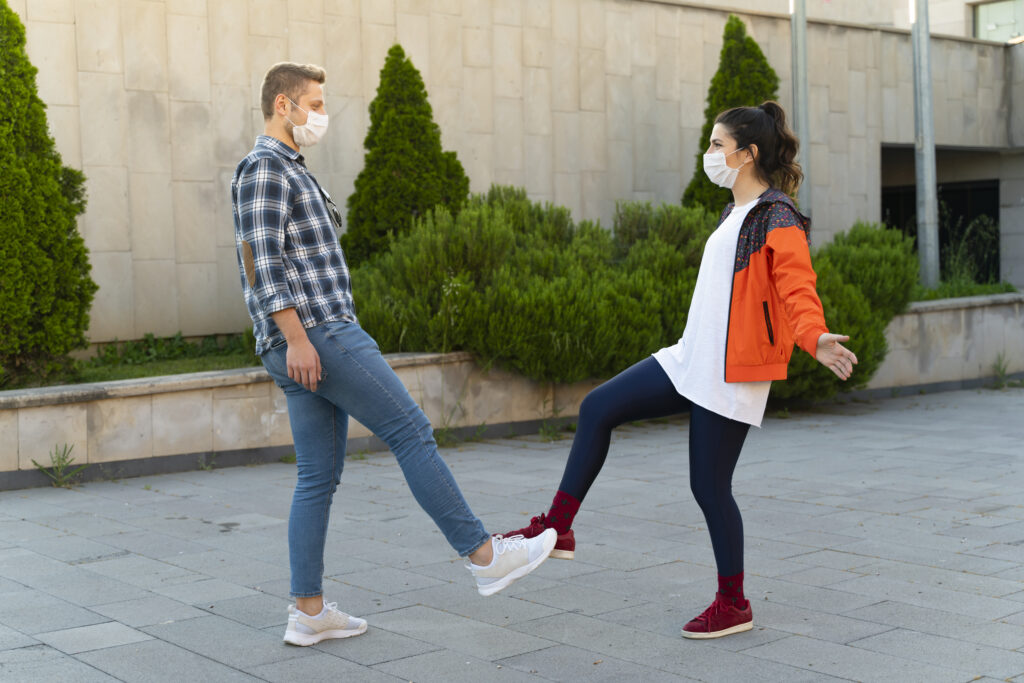
By: Maralee McKee
Most of us learned to shake hands when we were children, and we’ve been doing it ever since. Now, twenty, thirty, or more years later, it’s second nature to us. Shaking hands is a deeply rooted social custom in the U.S. and most of the Western world, and until a few months ago, it was considered good manners 101.
There’s a New Alternative to Shaking Hands That Allows for Social Distancing
Now, amid a pandemic, it’s anything but polite to extend your hand. In a matter of months, shaking hands has turned from a gesture of goodwill to one of lack of consideration for the health and safety of others. Yet for many of us, our right hand, almost instinctively, extends toward the other person.
The good news is that there’s something to replace the goodwill, respect, and kindness expressed with a handshake! This new action also uses our right hand. Yet it does so while respecting the need for social distancing. It’s called the Social Distance Greeting, and it’s how we can “shake hands” during a pandemic, and perhaps beyond.
A Brief History of Handshaking
Handshaking has been around since at least the ninth century B.C. According to this article on History.com, initially, the clasping of hands was used for the official “signing” of a deal or the agreement of a joint alliance. Two hands would clasp as one in unity.
Later, it was used by the Greeks and Romans to show that persons were meeting one another unarmed. The History.com article goes on to state that the up-and-down motion of handshaking was possibly added as a way to dislodge any weapons hidden in the sleeves of a garment.
Handshaking wasn’t used as a daily greeting until the 17th century when the Quakers thought of it as a better greeting for everyday use than the bowing, hat-tipping, and curtsying that was commonplace. By the time of the Victorians, rules for proper handshaking appeared in etiquette books. And ever since, it’s been the norm for greeting in most of the Western world.
Why a Handshake “Feels Good”
If meeting someone without shaking hands doesn’t “feel right” to you, you’re onto something. Scientists agree. As stated in Psychology Today by author David B. Givens, PhD:
Since the fingertips and palmar surface of the hand are exquisitely sensitive, the shake itself can be deeply personal. We instantly feel the warmth or coolness, dryness or moistness, and firmness or weakness of another’s grip. Sensory input from a hand’s thermal and pressure receptors to the brain’s parietal sensory area can be intense (especially in courtship). From the parietal lobe, the handshake’s message travels to deeper areas of the limbic system for an emotional interpretation to judge how the shake felt.
Put another way; the handshake is the only acceptable form of touch that’s considered acceptable among people who aren’t intimate with one another in most of the Western world. And in this time of social distancing, a lot of us miss the physical connections made through handshaking.
Many of us enjoy a great handshake. And if you’ve ever received a “bad” one, you might not be able to express why it didn’t “feel right,” but you sure know that it didn’t! That’s how deeply ingrained handshaking is in us. And because of it, we need a socially acceptable replacement during this time of social distancing.
The Social Distance Greeting is what to do right now instead of shaking hands.
What Is a Social Distance Greeting?
The Social Distance Greeting is the alternative to a handshake when meeting and greeting others, and any other time you would normally shake hands. It’s for use during the pandemic and perhaps beyond it.
The Social Distance Greeting offers the goodwill, kindness, and respect of shaking hands. It also puts the palms of our hands and fingertips to use so that we mimic, as closely as we can, the important sensory perceptions of a handshake.
The Four Easy Steps of a Social Distance Greeting

Here’s the easy how-to of the Social Distance Greeting:
- As you see the person approach, if you’re able to stand, stand up.
- Smile! And yes, people can sense your smile even through your mask. It acts as your non-verbal invitation to approach.
- Make eye contact! Our eyes are the windows into our thoughts and intentions. And now, with so much of our face covered with a mask, eye contact is more necessary than ever in making an inviting first and lasting impression.
- To offer a Social Distance Greeting, all you need to do is place the four fingers of your right hand together, and then place the palm of your right hand slightly above your heart with your pointer finger touching your collar bone. As for your left arm, simply allow it to fall into place at your side. It’s easy and quick! And placing your hand near your heart, even for two or three seconds, signals your friendliness and good intentions towards others much like shaking someone’s hand for two or three seconds.
How to Make Your Social Distance Greeting Even More Welcoming
While the following two etiquettes aren’t necessary, if you use one or both, as long as they come naturally to you, you’ll express an extra degree of approachability and friendliness.
- Slightly nod your head while your hand is over your heart. Why? As stated in PsychMechanics by Hanan Parvez, body language experts agree that the head nod is almost universally understood to mean yes. Your nod is signaling Yes, I’m happy to meet you. Similar to the slight nod of greeting and acknowledgment you give when you notice a friend at a party on the other side of the room, nodding during a greeting signals friendliness and agreeability to meet or greet the other person. It’s a non-verbal way to say, “Yes, let’s talk.” Or, “Yes, let’s meet.”
- Slightly tilt your head while your hand is over your heart. Why? When you expose your neck, you’re showing a vulnerable part of your body similar to the ancient days when extending your arm and hand showed that you weren’t in defense mode. Mr. Parvez states: “When someone tilts their head in your presence, they’re non-verbally telling you, ‘I trust you not to harm me.’ Interestingly, if you tilt your head while speaking, the listener will trust your words more.”
Offer a Social Distance Greeting Instead of These Common Alternatives to Shaking Hands
Of the many alternatives to the traditional handshake, here are things you don’t want to do, along with why they aren’t your best option.
Why You Don’t Want to Offer an Elbow Bump

There are several reasons why the elbow bump, sometimes called the Chicken Wing, is one of the things not to offer as a substitute handshake during this time:
- You’re not maintaining the proper six feet of social distance recommended by the CDC.
- The CDC recommends that we cough into the inner arm part of our elbow. If the person recently coughed without a mask on, you’re now potentially exposing yourself to any lasting particles.
- It’s harder to line up elbows than it appears! “Close enough” isn’t the signal you want to send with your greeting.
Why You Don’t Want to Offer a Fist Bump

There are a few reasons why the popular fist bump isn’t a suitable alternative to a handshake or Social Distance Greeting at this time.
- Unless both persons are fully extending their arms, they are standing closer together than the six feet of social distancing recommended by the CDC.
- Depending on when the other person last washed hands or applied hand sanitizer, you may be exposing yourself to the virus.
- Meeting or greeting someone with a clenched fist, the sign of aggression and hostility, sends mixed signals. To “soften” the fist bump, some people immediately afterward extend their fingers and spread them apart to signify fireworks or a bomb burst. Again, it’s sending mixed signals. And it doesn’t proclaim, “I’m the professional who will get you the results you want.”

Group fist bumps, as shown in the photo above, were often used as a substitute for needing to give each person in a group a “high five.” However, for the reasons stated for why fist bumps aren’t appropriate during the pandemic, the group fist bump isn’t suggested either. It’s everything that’s unhealthy about the fist bump multiplied by the number of people taking part.
Why You Don’t Want to Offer a Foot Shake

The “foot shake” or “toe tap” looks silly, and it doesn’t make for an excellent first encounter. Perhaps, if you’re a professional dancer, you have the balance needed to stand on one foot and to “click” feet without breaking the eye contact that’s an important part of any positive impression. But imagine doing it in heels! Case closed on this one!
Will the Social Distance Greeting Permanently Replace Handshaking?
Will the Social Distance Greeting last after the pandemic? I hope not. I’m eager to follow best practices from the CDC, and that’s why I’m not currently shaking hands.
However, the time will come when the likelihood of contracting the virus is either completely or greatly diminished. When that time arrives, I don’t want to live in a scary “What if?” scenario of a second wave of the virus despite a vaccine, or the onslaught of a future unknown pandemic. And I look forward to the return of shaking hands.
However, there are two sides to everything. I absolutely recognize merits in not wanting to shake hands in the future. In fact, back in 2014, there was already talk of banning handshaking between doctors, health care workers, and patients in medical settings.
Only time will tell whether, and in what circumstances, handshaking returns.
The Social Distance Greeting respects social distancing and is a friendly, kind, easy alternative to meeting strangers and greeting coworkers, clients, and friends. Because of this, it’s the perfect alternative to shaking hands during this time when handshaking isn’t the best practice.
Wishing you health and blessings galore,

Maralee McKee, Founder, The Etiquette School of America www.EtiquetteSchoolOfAmerica.com
